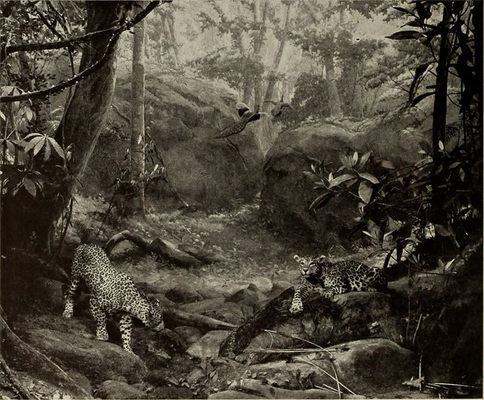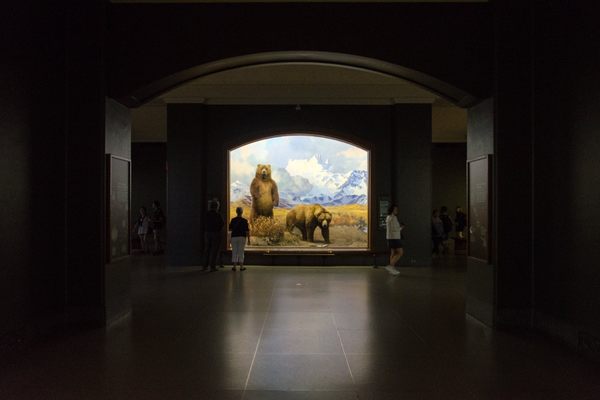About
In the dappled shade of the jungle, in a dried-up streambed, a leopard has killed a peafowl. In this scene, which is one of the oldest taxidermy dioramas at the American Museum of Natural History in New York, the lithe spotted cat has been caught in a moment in time reclining on a rock. One of its paws rests possessively across its dead prey, as a long tail feather protrudes almost comically from its mouth.
This fierce feline appears to gaze toward the viewer on the other side of the glass menacingly; its body posture shows tension and its whiskers are drawn back in what may become a threatening snarl or hiss. A second leopard, perhaps the first's grown offspring or its mate, is seen tentatively stepping from the shadow of the surrounding foilage into the glade. This big cat approaches the bird's carcass in an attitude of curiosity, its intentions evidently being either to dine on, sniff, or simply to play with the disheveled remains.
The unfortunate prey itself lies amongst the rocks. Many of the peacock's iridescent and vibrant plumage tail feathers have come loose from the impact of the pouncing predator and litter the rocks. The dead bird's long-tailed companions can be seen in the painted background scene flying away into the forest in alarm.
This suggests that the diorama is a snapshot of the aftermath of an ambush attack on thirsty peafowl that had converged on the streambed in the dry season to drink from any remaining puddles of water. Although the leopard is a predator found widely across both Asia and Africa, the presence of the blue peafowl prey indicates that this scene portrays the wilds of the Indian subcontinent. The setting of the diorama is specifically intended to be a forest in the southern Mysore region of the Western Ghats in southwest India, where these taxidermy specimens were collected in the early 1900s.
Today the forest ecosystems of the Western Ghats continue to shrink in the face of human pressures like logging and land conversion for agriculture. But both species, unlike many of the animals portrayed in the dioramas of the Asian Hall of Mammals, have shown remarkable tenacity in adapting to the changing environments of 21st century India. Indeed, the leopard has even been found to be thriving in the city parks of Mumbai, Kolkatta, and Delhi, where it typically goes virtually unnoticed by the millions of humans that surround it.
Related Tags
Know Before You Go
The American Museum of Natural History (AMNH) is open from 10 a.m. to 5:45 p.m. every day. Entrance is free, but it is strongly recommended to contribute a small donation to the museum to help with its upkeep and outstanding scientific work. The leopard diorama can be found in the excellent Hall of Asian Mammals, where there are many other incredible dioramas to see.
Community Contributors
Added By
Published
August 7, 2019




























